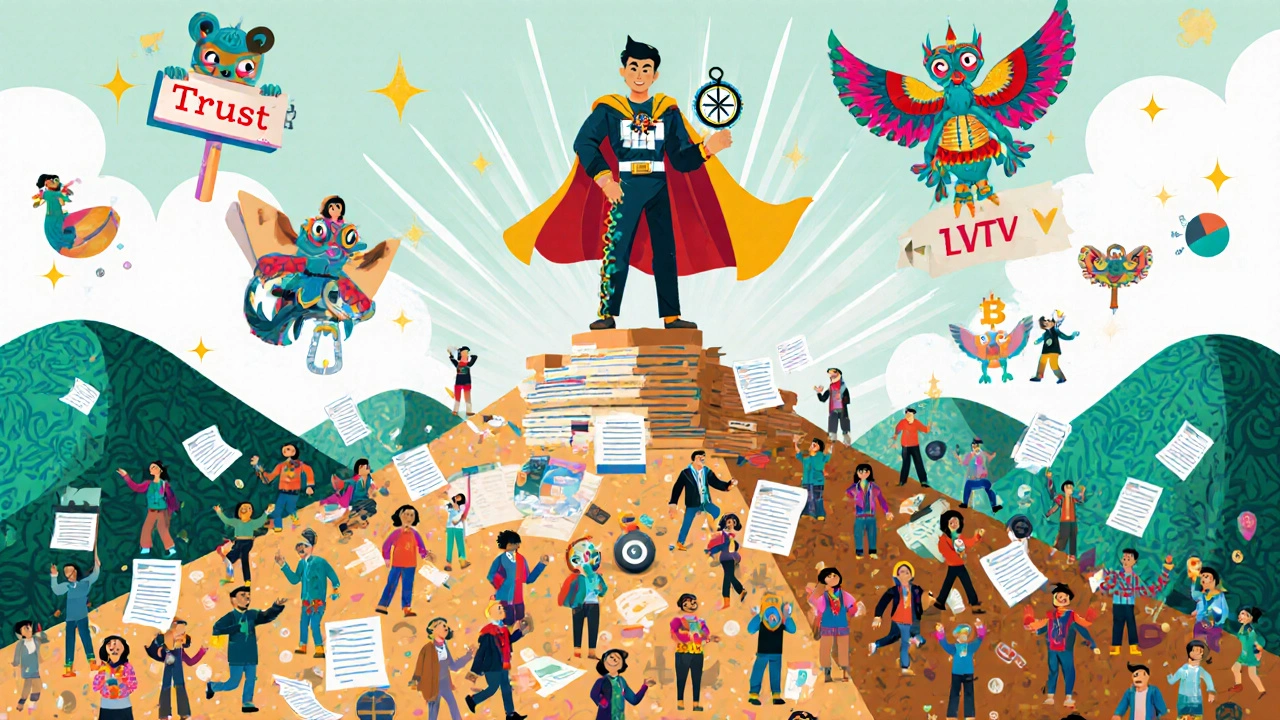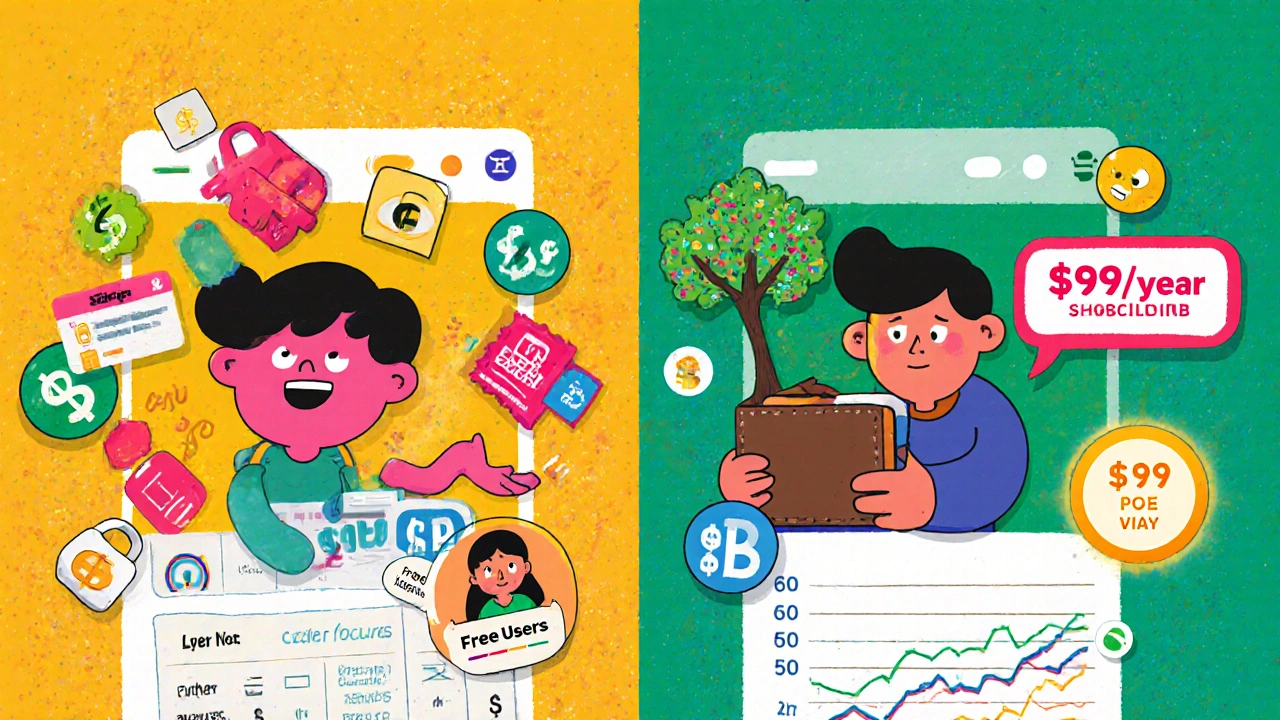Finance App Monetization Calculator
App Metrics
Key Insights
Most finance apps start with a simple question: should we charge upfront or give it away for free? It’s not just about money-it’s about trust, behavior, and survival. In 2025, over 70% of new finance apps launch with a freemium model. But the ones making real money? Many of them are paid. Here’s what actually works-and why so many apps fail at both.
Freemium Apps Trap Users in a Free Loop
Freemium apps look like a win: download it, connect your bank, start budgeting-no cost. But here’s the truth most people don’t admit: most free users never pay. Data from Arbisoft shows that only 2-5% of freemium finance app users ever upgrade. That means 95 out of 100 people who try your app will walk away after a few weeks. Why? Because the free version is designed to hook, not to solve. You can track spending. You can set budgets. But if you want to sync more than two accounts? That’s $4.99/month. Want to see your net worth over time? Pay up. Want to export tax-ready reports? Premium only. Users feel tricked. Reddit threads like "Why does every budget app hide the basics behind a paywall?" aren’t rare. In fact, 62% of negative reviews on freemium apps mention this exact frustration. The app feels useful until it hits a wall-and that wall is a credit card field. And here’s the kicker: freemium apps rely on data collection to survive. Ads, referral partnerships, behavioral tracking-none of that works if you’re bound by GDPR or CCPA. As privacy rules tighten, those hidden revenue streams are drying up. Deloitte found that 38% of freemium finance apps have no clear path to profit if they can’t sell data. That’s not a business model. That’s a countdown.Paid Apps Win Loyalty, Not Downloads
Paid apps don’t get many downloads. Preapps’ 2021 data showed paid finance apps get only 4.4% of total app store traffic. But here’s what they do get: users who care. When someone pays $29.99 upfront for a finance app, they’re not just buying software. They’re buying commitment. They’re saying, "I’m serious about my money." That changes everything. Take YNAB (You Need A Budget). It’s $99/year. No free tier. No ads. No upsells. And yet, it keeps 85% of its users after two years. That’s not luck. That’s design. YNAB doesn’t just track spending-it teaches you to stop living paycheck to paycheck. The app’s entire interface is built around that philosophy. You don’t pay for features. You pay for transformation. Paid apps also avoid the trust problem. Finance is scary. People worry about hackers, data leaks, shady third parties. A paid app doesn’t need to collect your data to make money. It doesn’t need to show you ads for credit cards. It doesn’t need to prove it’s safe-it just needs to be safe. Quicken Deluxe uses 256-bit encryption across every feature. No exceptions. That kind of consistency builds trust faster than any free trial ever could.
Revenue Isn’t About Volume-It’s About Value
Let’s compare numbers. A freemium app might get 500,000 downloads. At a 3% conversion rate, that’s 15,000 paying users. If they pay $5/month, that’s $900,000 a year. Sounds good. But here’s the catch: 63% of those free users abandon the app within 30 days, according to Columbia University’s behavioral study. You’re spending money on server costs, customer support, and app updates for people who aren’t even trying to use your product. Now look at a paid app with 50,000 downloads at $29.99. That’s $1.5 million in upfront revenue. No monthly server drain from millions of inactive users. No ad-tech headaches. No compliance nightmares from data harvesting. And because users are committed, retention is higher. The average paid finance app user sticks around 18 months. The average freemium user? 4 months. LTV (lifetime value) tells the real story. Paid app users average $45-$120 in lifetime value. Freemium? $3-$15. That’s not a difference in pricing. That’s a difference in user quality.The Hybrid Model Is Winning Right Now
The smartest apps aren’t choosing one or the other. They’re blending them. Monarch Money started as freemium. Then they switched to a $9.99/month subscription-with a 30-day free trial. Result? A 35% drop in downloads. A 220% jump in revenue per user. That’s not a loss. That’s a cleanup. Empower (formerly Personal Capital) went even further. They don’t charge a subscription. They charge based on your assets. If you have $100,000 saved, they take 0.25% a year. No monthly fee. No paywall. Just value tied to your success. That’s the future: pricing based on outcomes, not features. Apple’s 2022 policy change forced freemium apps to be transparent about in-app purchases. Conversion rates dropped 12-18%. That’s not a bug-it’s a feature. Users are tired of hidden costs. They want to know what they’re paying for before they download.
What Should You Build?
If you’re building a finance app, ask yourself these questions:- Are you targeting people who are just starting to budget? → Freemium might help you get noticed.
- Are you solving a deep, painful problem like debt repayment or retirement planning? → Paid works better. People pay for relief.
- Do you have the tech to handle millions of users without crashing? → Freemium needs serious infrastructure.
- Can you deliver clear, consistent value without collecting user data? → Paid is your only clean option.
Why Most Finance Apps Fail
TechCrunch found that 89% of finance apps die within two years. Why? Because they confuse volume with value. Freemium apps grow fast, then flatline. Paid apps grow slow, then scale. The ones that survive? They don’t chase downloads. They chase trust. If you’re building a finance app, don’t ask, "How do I get more users?" Ask, "How do I earn the right to keep them?"Is freemium better for new finance apps trying to grow fast?
Freemium can help you get downloads quickly, especially if you’re targeting younger users or markets where people are wary of paying upfront. But growth doesn’t equal sustainability. Most free users never convert, and the server and compliance costs can eat your profits. If you go freemium, you need a clear path to revenue beyond ads-like affiliate partnerships or premium support tiers.
Why do paid finance apps have higher user retention?
When you pay for something, you’re more likely to use it. Behavioral studies show that paying upfront creates psychological commitment. Users of paid apps like YNAB treat the app as a tool for real change, not just a toy to try. They open it weekly, track progress, and stick with it-even when life gets messy. Free users? They download, play around for a week, then delete it when they get distracted.
Can a finance app succeed with both freemium and paid options?
Yes-but only if the tiers are clear and valuable. A free tier should offer real utility (like basic budgeting and spending insights), while the paid tier must solve a bigger, more urgent problem (like tax planning, investment tracking, or debt payoff strategies). Don’t gatekeep core features like bank syncing-that’s what turns users off. Instead, make the free version useful enough to build trust, and the paid version indispensable enough to justify the cost.
Are subscription models better than one-time payments for finance apps?
Subscriptions are better for long-term revenue and predictable cash flow. One-time payments give you a big upfront win, but you lose money every time a user stops using the app. With subscriptions, you keep earning as long as they stay. Plus, you can add features over time and charge for upgrades without asking users to pay again. Most successful finance apps today-like Monarch Money, YNAB, and Empower-use monthly or annual subscriptions.
What’s the biggest mistake finance app makers make with pricing?
They assume users will pay for features. They don’t. Users pay for outcomes. Don’t sell "bank syncing" or "net worth tracking." Sell "peace of mind," "control over debt," or "confidence in retirement." Price based on the transformation, not the tool. And never hide essential features behind a paywall-that’s how you lose trust before you earn it.

RAHUL KUSHWAHA
November 15, 2025 AT 19:37Man, I tried like 5 budget apps in India-all freemium. Free version lets you track expenses but blocks bank sync? 😒 I just deleted them all. Paid apps here are rare, but when I found one that didn’t beg for my data? I paid upfront. No ads, no tricks. Just works. 🙏
Julia Czinna
November 17, 2025 AT 17:46I used to think freemium was the only way to scale, but after watching my sister struggle with an app that locked her net worth tracker behind a $5/month paywall, I changed my mind. She’s not a power user-she just wants to know if she can afford groceries next week. That’s not a premium feature. That’s basic. Paid apps that respect users’ intelligence don’t need to trick them into paying. They just earn it.
Dave McPherson
November 19, 2025 AT 15:03Oh sweet Jesus, another ‘freemium is evil’ manifesto. Let me grab my monocle and monocle holder. The truth? Most people are too lazy to pay for anything unless it’s a Netflix subscription or a Tesla. Freemium isn’t a trap-it’s a funnel. You filter out the chumps who just wanna ‘try stuff’ and keep the ones who actually care. And guess what? The ones who pay? They’re the ones who’ll defend your app in Reddit threads like it’s their firstborn. Meanwhile, the free users? They’re just digital hoarders. Downloading 17 finance apps because ‘maybe this one will fix my life.’ Spoiler: it won’t. And neither will your guilt-trip UX.
Also, ‘pricing based on outcomes’? That’s just corporate speak for ‘we’re charging you more because you’re rich.’ Congrats, Monarch Money-you turned financial wellness into a luxury good. How very Silicon Valley of you. I’ll stick with my spreadsheet and a cold brew.
Kenny McMiller
November 20, 2025 AT 21:42Here’s the meta-layer nobody talks about: finance apps aren’t selling software-they’re selling epistemological security. People don’t want to track expenses. They want to believe they’re in control. Freemium exploits that by dangling the illusion of agency-‘Look, you can budget!’-but then yanks it away when the anxiety peaks. Paid apps? They don’t offer features. They offer ritual. YNAB isn’t an app-it’s a daily prayer. You open it. You input. You reflect. You feel like you’re doing the work. That’s why retention’s high. It’s not about the UI. It’s about the psychological contract. The free version breaks that contract. The paid version sanctifies it. And in a world where everything’s gamified and monetized, that’s the last real thing left to sell: dignity.
Also, the ‘hybrid’ model? That’s just freemium with a prettier veil. If your free tier doesn’t deliver real, non-gated value, you’re not building trust-you’re building a conversion trap. And trust? You can’t monetize trust. You can only earn it. And once you do? You don’t need to upsell. They’ll stay. Because they’re not users. They’re believers.